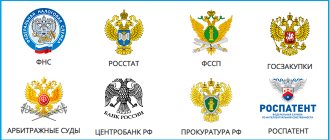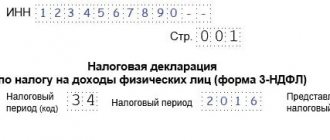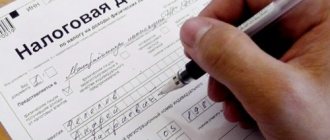From time to time, each legal entity or individual may need to find out the code of the tax authority to which this person belongs. The fact is that it is necessary to fill out some reporting forms. In this material we will talk about tax authorities and provide step-by-step instructions on how to find out the tax authority code.
The tax authorities of our country are represented by an integral system of a centralized nature. They exercise control over taxpayers and the timely fulfillment of their obligations to the state, which consist in the transfer of tax contributions to the country's budget. In addition, the tax system ensures law and order in all aspects of tax relations. It is represented in Russia by the Federal Tax Service, which has numerous divisions. It belongs to the executive branch, and is a “branch” of the Ministry of Finance of the Russian Federation.
How to find out the tax authority code
What numbers does the Federal Tax Service code consist of?
First you need to know what the Federal Tax Service code is. It is a special tax authority code, which consists of four digits:
- the first two digits represent the code of the subject of the Russian Federation;
- the other two are the code of the tax authority that operates in a certain territory, located at a specific address and having certain details.
Cases in which a Federal Tax Service code may be needed can be very different. Among the most common for individuals:
- in case of assignment of a TIN. To do this, you need to have information about which tax authority you need to contact;
- in case of filling out tax returns (3-NDFL, etc.);
- in case of payment of taxes of different categories: property, transport, land, etc.
Legal entities may need the Federal Tax Service code:
- in case of registration;
- in case of reporting. The Federal Tax Service code must be indicated in the declaration.
Some educational information
The tax service system as it currently operates was established in September 2004, according to a government decree. It legally represents the Russian Ministry of Finance and regulates tax relations in the country.
The power inherent in this service is executive in nature. Some of her responsibilities include conducting the registration procedure:
- for legal entities;
- individuals acquiring the status of individual entrepreneurs.
In addition, the service is authorized to represent various cases concerning the ruin (bankruptcy) of people and organizations, claims payments for financial obligations, etc.
The tax office works in conjunction with other systems:
- located at the federal level and holding executive power;
- located in the territories of constituent entities of the Russian Federation, also representing executive power;
- responsible for local self-government;
- country funds outside the budget;
- social unions;
- other organizations.
The centralized system in question is represented by a network of territorial offices located in each subject of the Russian Federation.
Table 1. Main tasks of tax authorities
| Task | Description |
| Monitoring compliance with the law | Carrying out control activities, monitoring compliance with legal norms regarding the deduction of taxes to the treasury, including the correctness of the procedure. Mandatory attention is paid to the completeness of the amount and timeliness of the payment. |
| Public policy development | Carrying out the development of state policy regarding tax relations and the introduction of measures selected for implementation in order to ensure full and timely filling of the budget with tax deductions. |
| Currency control | Exercising control over currency within the scope of issues relating to the service. |
In addition to its obligations and tasks, the tax service has the right to exercise certain powers. Let's look at them in detail.
- Monitor and supervise how compliance with tax legislation is carried out, while checking how correctly, timely and completely taxpayers have paid their due deductions to the state treasury. In addition, they monitor the authorities and work of tax agents who calculate deductions. The correctness of documents, various forms, declarations and certificates is also checked. Together with the transfers, they are submitted to the tax service for the reporting procedure.
- The Tax Service monitors currency transactions carried out by people who are tax residents of the country and who are not.
- The powers of the system also include the implementation of the registration procedure for persons: individuals;
- legal.
- persons obliged to pay taxes in the register of taxpayers;
- what current fees and deductions to the state are valid today;
- notifications sent to taxpayers containing requirements for payment of deductions;
- IP;
In addition to powers, the service has rights. Let's look at them in the list below:
- The Service has the right to carry out regulation of a legal nature, but only in cases where this is provided for in the Federal Law, decrees of the Russian President or government regulations.
- The service’s rights also include requesting documentation from taxpayers, which may serve as confirmation of the correctness of the accrual and payment of taxes, in addition to the fact that this procedure was carried out on time.
- The right to conduct control checks, during which to seize the necessary documentation confirming the commission of violations in the field of tax legislation, but only if there are assumptions that it may soon be destroyed or modified.
- Require tax payers to provide any explanations regarding tax deductions made by them on the territory of the tax authority.
- Stop carrying out transactions on the bank accounts of the payers of deductions, as well as seize the property in their possession.
- Conduct an inspection of premises that the taxpayer may use, be it: warehouses;
- outlets;
- rooms of a different type.
Methods for determining the Federal Tax Service code using the Taxpayer Identification Number (TIN)
The TIN itself already contains information about the citizen’s affiliation with a specific Federal Tax Service. TIN is a combination of 10 digits in which information about a citizen is encoded. In order to find out the Federal Tax Service code, it is enough to take the first four digits of this combination. Those. The first four digits of the TIN contain information about the Federal Tax Service code.
How to find out the Federal Tax Service code when moving to another place of residence
It is worth noting that the Federal Tax Service code is assigned precisely at the place of registration. If you moved to another region of the country, you will have to find out the Federal Tax Service code in another way. For example, on the website of the tax service. To do this, go through a series of steps:
- Go to nalog.ru.
- The main page of the site will open. To begin, check the appropriate box in the “Taxpayer Type” category. This may be an individual or legal entity.
- Fill in the address where you need to indicate some information: zip code, name of the subject of the Russian Federation, full address - street, house, apartment, building, etc.
- Click OK.
- The requested information will appear: four digits of the Federal Tax Service code and the name of the municipality.
Obtaining information about the Federal Tax Service code from the tax authority and by phone
In addition, when moving, you can find out the Federal Tax Service code by contacting the tax authority itself, if free time allows. Many of them work by appointment. Therefore, before visiting, you need to go through a number of steps:
- Go to the website www.nalog.ru.
- Agree to the terms of use by clicking the appropriate button.
- Fill out information about yourself: full name, tax identification number, contact phone number and email.
- Click Next.
- Select the region and address of the tax office you want to visit.
- Please select the service you would like to contact.
- Select the date and time of your planned visit.
- Click "Confirm".
- At the appointed time, contact the tax authority to obtain the Federal Tax Service code. You can also restore your TIN in case of loss in order to view this code using it.
If you don’t have free time, you can contact the hotline 8-800-222-2222. Please clarify your question with the operator.
Find out the tax authority code: detailed instructions
As we have already said, codes from one of the tax service departments are almost always used to fill out important papers, tax forms, declarations and other reporting forms to the system. They are represented by a certain set of numbers, there are four in total. Each service branch is assigned an individual combination, divided into two parts:
- the first two digits indicate the region in which the service branch is located;
- the second two digits are individual for each branch.
When filling out the declaration paper for reporting, the taxpayer enters inside the code of the service department to which he belongs according to:
- place of residence;
- conducting activities, etc.
So, what are the ways to find out the code of the tax office that you personally belong to? Let's look at the options we came up with and analyze each in detail.
According to the taxpayer's residential address
You can find out the code of the tax service department in order to enter it into the document according to your residential address.
Enter the address on the service website and find out the code
Step No. 1 – open the official website of the service
Let's go to the electronic resource of the tax service. This service helps taxpayers determine the details of the required Federal Tax Service inspection. With its help, you will receive the necessary information without leaving the walls of your home, and without even getting up from your desk.
Step No. 2 – enter the data into the form that opens
The data entry procedure has been simplified to the point of impossibility. First of all, you need to select the type of taxpayer, there are two options:
- entity;
- individual.
Then you need to indicate the address of the payer. An additional window will open in which you can fill in the following columns:
- index;
- subject of the Russian Federation (you can specify the region code with a number and the system will find the city automatically);
- address (Moscow, Lenina St.);
- House number;
- building body;
- apartment number.
As soon as the filling is completed, the column “IFTS code” will be automatically filled in, in which the four-digit code of the authority will appear.
Note! Depending on the selected type of taxpayer, the code may change due to a change in the person’s affiliation with the tax branch.
By taxpayer identification number
This number is assigned to each payer of contributions to the treasury individually; everyone has their own. When you receive the certificate containing it from the inspection, you also receive a tax registration, therefore, its code is also included in the required identification number.
You can find out the code using a certificate of assignment of an individual taxpayer number
Step No. 1 – find evidence
Just take it out of your folder or any other place where you keep important papers.
Step No. 2 – determine the inspection code
Please note the identification number. Its first four numeric values are the code of the tax office to which you belong. It is followed by six more - these are already personal, individual numbers for each individual. The remaining two mark the certificate itself and are needed to facilitate its finding in databases.
TIN structure, excerpt from the order of the Federal Tax Service of Russia N ММВ-7-6/435
Personal inspection visit
You can find out the inspection code the old fashioned way by visiting the tax office you went to before or the closest one. Even if you are not one of them, his staff will provide advice in any case.
Personal visit is another option for finding out the code
Step No. 1 – sign up for a consultation
It may not be possible to simply come to the service and get a consultation on a first-come, first-served basis; it is best to get an appointment by appointment. By the way, you don’t need to visit the tax office twice to do this. Just open the Internet, go to the official electronic resource of the Federal Tax Service, go to the appropriate section and sign up for the queue online by filling out the form.
It must indicate:
- what type of taxpayer you are;
- last name, first name, patronymic of the visitor;
- taxpayer identification number;
- cellular telephone;
- E-mail address.
Before planning a trip to a branch of the service, it is best to check on the same electronic resource what hours consultations are held, when it is lunch break, etc.
Step No. 2 – visit the inspection
On the day appointed for consultation, attend the inspection. If you don’t know where to go next, you can get information from the person at the reception or at the information desk. It is best not to be late, because this can anger the consultant and reduce his level of disposition towards you.
We make a call to the Unified Contact Center of the Tax Service
The last method, which also does not oblige you to leave your home to clarify the inspection code to which you belong, is to call the service’s Unified Contact Center from your phone. It is free for residents of any region since 2015.
Consultations provided by this number may relate to:
- time frame for payment of tax contributions;
- stages and nuances of the registration procedure;
- receiving tax deductions for taxes paid;
- using tax service services located on the Internet;
- work schedule of local inspection offices;
- inspection codes, etc.
As you can see, the list is quite extensive, therefore, in addition to the inspection code, you can ask many questions on other topics that interest you.
When working, contact center operators use not only their own knowledge, but also a federal information base, so you can be sure that the data received is correct.
Step No. 1 – call the Unified Contact Center
You can make a call to the Unified Contact Center from a cell phone or landline by dialing the following number: 8 800-222-22-22 . If all operators are busy at the time of the call, do not rush to hang up, wait a few minutes until one of the consultants is free.
Step #2 – ask a question
When you call, you have unlimited time to talk with the operator. Of course, there can be no talk of idle chatter, but there is no need to rush either. Find out the code, write it down on paper or on your phone, and then ask the remaining questions.








